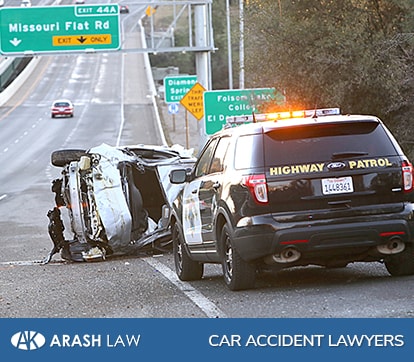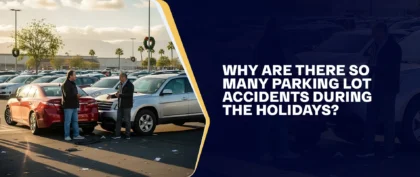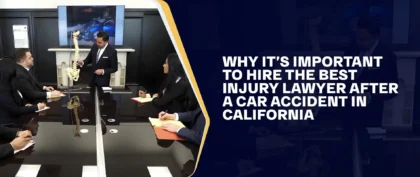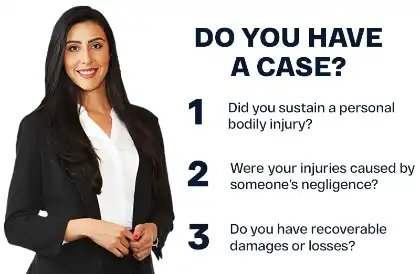Table of Contents

As accident lawyers, we have handled accident claims involving different types of vehicles and understand how the size of the car can significantly impact the severity of injuries. But how do you know which is the safest vehicle to drive? Are bigger cars more reliable? Are SUVs safer than cars? Where would you be able to find car crash test data? How do you know you can trust that data? All of these questions are important to answer when selecting the vehicle that is right for your family and lifestyle.
Are Bigger Cars Safer Than Smaller Cars?
Generally, big cars are considered safer than small cars. There are several important reasons for this. First, in a larger car versus a light car crash, physics favors the more massive vehicle. Momentum is a product of mass and velocity.
Of course, large car versus small car safety is a far more complicated issue than which vehicle has more momentum in a collision. A vehicle’s safety also considers its ability to withstand a crash or even help the driver avoid an accident altogether. The driver’s experience and comfort with the vehicle’s features are also critical components of the safety equation.
Why New Cars Are Safer Than Older Cars
Before we discuss small cars’ risks versus large vehicles, it is crucial to understand that new cars have a general safety advantage over older vehicles. Even the National Highway Traffic Safety Administration has made a clear statement: New Cars Are Safer Cars. Over the years, vehicle manufacturers have made incredible improvements to vehicle designs and safety features. These improvements have helped reduce the severity of injuries that are sustained in a motor vehicle collision, which, in turn, reduces the number of fatalities that are suffered in auto accidents.
Vehicle Mass And Crash Resistance
Many of the classic American cars of the 1950s and 1960s were large. Manufacturers such as Cadillac advertised a comfortable, luxurious ride with plenty of space inside the vehicle. The downsides of this feature did not become apparent until the gas crisis of the 1970s. With gas in such short supply, suddenly smaller was better.
Unfortunately, manufacturers had not yet learned how to design small vehicles that could withstand collisions. These smaller vehicles were highly vulnerable on the road. Today’s small cars carry new safety features that mitigate some of these risks. In serious collisions involving vehicle size disparities, accident lawyers can help evaluate liability and assist victims in pursuing legal claims related to the crash.
Crumple Zones
You may not even know about one of these critical safety features, which is the crumple zone. Crumple zones are areas within the structure of your vehicle that are designed to collapse on impact. This collapse absorbs the force of the collision and diverts it away from the occupants of the car. Bumpers are areas for absorbing impact, but your vehicle’s steel frame can collapse in other areas, too.
Some drivers around California fail to replace their bumpers after an accident. Doing so leaves the car without critical safety protection in the event of a collision. Even a minor rear-end collision could leave you with serious injuries if your rear bumper doesn’t protect you.
Safer Systems
Crumple zones are not the only safety features that have narrowed the safety gap between small vehicles and larger ones. Anti-lock braking systems, three-point seat belts, backup cameras, lane drift, collision warnings, electronic stability control, airbags, and many other safety features have dramatically improved the safety of all vehicles. Many of these features are now required in new cars, small and large alike.
It is important to understand how the safety features work on your particular vehicle. Research shows that many drivers do not fully understand how their vehicle’s safety features work. For example, many drivers thought the car would automatically brake for them in vehicles with a collision warning system. They did not understand that the car only provided warnings that a collision was imminent.
Shouldn’t We All Just Drive Bigger Cars?
It seems logical that, if bigger cars are safer, we should all drive them to reduce our risk of injury and death on the road. But a larger vehicle is not necessarily right for every driver. Here are some factors that might lead you to consider a lighter, smaller vehicle:
Small Cars Can Have Better Handling And Control
In many cases, small vehicles have better handling than larger vehicles. Drivers can respond to dangers on the road more quickly when driving a small car with better maneuverability. These extra seconds can be vital for preventing a collision. Of course, large vehicles have different degrees of maneuverability.
SUVs Have A High Risk Of Rollover
The center of gravity on a sport utility vehicle is higher than that of other cars. It is easier to tip over an SUV than a small car that is lower to the ground. It also means that drivers who are not used to driving an SUV might be more likely to roll the vehicle. A rollover is more likely to occur during rain, sleet, snow, and other conditions that make the roadway slick.
Fuel Efficiency And Environmental Concerns
Safety is not the only factor that car shoppers must consider. Here in California, high gas prices and environmental concerns have led many drivers to choose smaller vehicles that have less impact on the environment. Thanks to significant safety advances, many of these smaller vehicles now have safety ratings closer to larger vehicles. It is even possible to buy a small car with a better safety rating than a large car.
The Type Of Car You Are Comfortable With
Safety is mainly in the driver’s control. Responsible, attentive driving can help prevent more collisions and keep occupants safer than relying on your vehicle to keep you safe during an accident. If you are more comfortable and experienced driving smaller cars, you may be safer continuing to drive them.
Safety Rankings
The Insurance Institute for Highway Safety (IIHS) has extensive programs for ranking the safety of various vehicles. IIHS has access to large volumes of crash data thanks to insurance records from auto accident claims. IIHS also conducts tests on vehicle safety. Based on all this data, the IIHS can tell you a few things.
In addition to the IIHS studies, the National Highway Traffic Safety Administration (NHTSA) also conducts crash tests. The NHTSA tests examine different factors than the IIHS tests. NHTSA subjects vehicles to simulated front-impact and side-impact collisions. Front crash tests are measured by calculating the amount of force on the head, neck, chest, and legs of the crash test dummies.
According to Consumer Reports, the IIHS studies are considered more stringent than those performed by NHTSA because IIHS subjects test vehicles to higher forces. The IIHS also engages more of the target vehicle, which subjects it to more considerable damage. Finally, IIHS conducts rear, front, and side-impact collision tests, giving IIHS more comprehensive data about the amount of force to which a vehicle occupant is subjected during a crash.
Crash Test Scores And Vehicle Size
Unfortunately, the IIHS does not make safety rating comparisons across vehicle classes. So it is not, for example, possible to say that a sedan with a four-star rating is equally as safe as an SUV that also got four stars. While you can get actual data about how vehicles performed on the road, this is typically not available until the model year has been on the road for several years. It takes time to accrue the critical mass of data that allows statisticians to make accurate conclusions about a vehicle’s safety.
While IIHS does not compare crash test scores across vehicle classes, it does compare death rates. Consumer Reports reported the findings of its three-year study. The study found that fatality rates were much higher in small cars and minicars than in SUVs, pickups, and minivans. Large luxury SUVs had the lowest fatality rates.
Driver Death Rates
Though it might seem morbid, a key metric of vehicle safety is how well drivers can survive a vehicle’s collision. IIHS compiles data on driver fatality rates for various cars. Though it may be hard to think about, it is crucial to know how well a vehicle protects its occupants in a motor vehicle accident and how death rates are reported.
Why Can’t I Find Crash Data For Newer Model Years?
While safety tests can be performed before a vehicle is even released to the public, actual crash data takes much longer to compile. Complete vehicle registration data is usually not released for about two years. Fatality statistics are first available approximately nine months after the end of the calendar year. And even when these numbers are first released, there might not be enough data to be statistically significant.
The Types Of Injuries You Can Sustain In An Auto Accident
Regardless of what type of vehicle you are in, you can be injured in a motor vehicle collision. The types of injuries you sustain may affect the potential value of your claim. Your auto accident attorney will tell you that it is important to see a medical provider so that you can document your injuries. An attorney who can help you understand the potential impacts of your injuries and explain them to an insurance claims adjuster or jury.
Minor injuries sometimes resolve on their own, but you might also need ongoing treatment from a chiropractor or physical therapist. Common examples include:
- Concussions
- Cuts (Lacerations)
- Bruises (Contusions) and Swelling
- Whiplash
More severe injuries might require immediate medical attention or ongoing treatment from medical professionals. These types of injuries might be:
- Internal bleeding and broken bones.
- Cognitive or behavioral problems associated with a concussion, which is a form of brain damage.
- Damage to your kidneys, pancreas, liver, or other internal organs.
- Temporary damage to the spinal cord, such as bruising or swelling.
Severe injuries can result in permanent damage, such as:
- Partial or complete paralysis.
- Amputation of limbs.
- The inability to speak or communicate.
- The need for an organ transplant.
Regardless of the types of injuries you sustain, a driver found to be negligent may be held legally responsible for your injuries and losses. If your injuries are more severe, so can be the financial and physical damage you may sustain. In cases involving permanent injuries, these losses can be significant. The loss of future income, modifications to the home, pain, suffering, lost employment benefits, and many other types of damages may be taken into consideration in a personal injury claim. Injury attorneys can help assess these damages and guide victims through the legal process to seek financial compensation.
Wrongful Death Claims
Of course, the most severe car accident injuries can lead to death. In the early days of American law, there were only limited options to seek compensation for personal injuries that resulted in death. These days, wrongful death statutes enable eligible surviving family members to pursue damages if a loved one was killed through negligence.
Survivors may be able to pursue compensation for funeral and burial expenses, medical expenses before the victim died, any wages the victim could have earned for the remainder of his or her life, and other documented expenses related to the auto accident. Survivors may also be able to seek compensation for the intangible, but genuine, emotional losses they suffer after a wrongful death. This type of damage is known as “loss of consortium.” It compensates surviving spouses for the loss of marital companionship.
So who can file a wrongful death claim? The California Code of Civil Procedure identifies survivors who can file such a case. A few examples of such survivors are:
- A surviving spouse or domestic partner.
- Children or grandchildren (if the grandchild’s parents are deceased).
- Other minor children dependent upon the victim for at least half of their financial support (this commonly applies to stepchildren).
Sometimes, none of those people can be found. A wrongful death claim can then be brought by more distant family members who would inherit the victim’s property under the default rules of California probate law. These rules are known as “intestate succession.” They dictate who will be your heirs if you die without a will. If, for example, your children do not survive you, then your grandchildren will be your heirs.
How To Be Safe When Driving A Small Vehicle
If you do choose to drive a small vehicle, there are things you can do to make safer choices within that size class. Here are some tips for staying safe in a small vehicle:
- Drive Safely — Driver behavior is often regarded as a key factor influencing safety. What you drive is not nearly as important as how you drive. Be alert and aware of your surroundings. Keep your pets and children comfortable and safe before you leave, so there is less chance of being distracted while driving.
- Drive Defensively — Even the safest driver is still at risk from other drivers on the road. It is essential to be aware of what other drivers are doing and how that could impact your safety. Don’t engage with an aggressive driver. Let them speed ahead of you and get out of your zone of danger.
- Make Safer Choices When Buying Within the Size Class — If you choose to go with a smaller vehicle, check the safety ratings within that particular size class. Some small cars perform better than others in crash tests. By selecting the safer option, you may help reduce the risks of an accident on the road. You should research as many models and model years as you can find.
- Understand the Safety Features of Your Vehicle — Drivers can suffer from a lack of knowledge about their vehicle’s safety features. Research the features that are important to you. Learn more about these features and how they affect your selected vehicle’s crash test ratings and driver fatality rates. Once you purchase the vehicle, test these features out in a safe setting, such as an empty parking lot.
After Any Car Accident, Consult With An Experienced California Auto Injury Lawyer To Understand Your Legal Rights
Vehicles carry the risk of injury. No matter what car you buy, it is possible to be injured in an accident caused by a negligent driver. When this happens, it is important to understand your legal options. California car accident lawyers can help determine if you have a viable claim and guide you through the legal process. Regardless of where you are in California or what type of auto accident you were involved in, Arash Law is ready to help. We offer our legal services in San Francisco, Riverside, San Jose, San Diego, Sacramento, Sherman Oaks, and other areas in California. Our motor vehicle accident attorneys have years of experience in representing injury victims throughout California. Contact Arash Law at (888) 488-1391 or complete our “Do I Have A Case?” form here to schedule your free initial consultation.






























